Animals4
Download as ppt, pdf0 likes440 views
This document lists various sea creatures including clam, crab, eel, hammerhead shark, jellyfish, killer whale, lobster, octopus, ray fish, seahorse, prawn, squid, starfish, swordfish, and tadpole.
1 of 16
Download to read offline
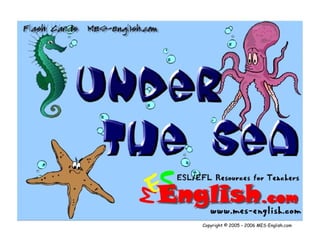
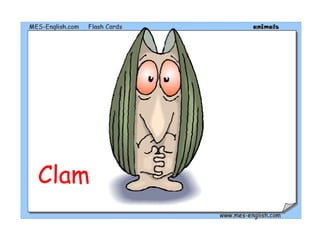
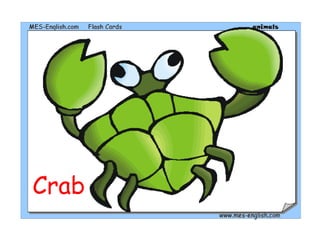

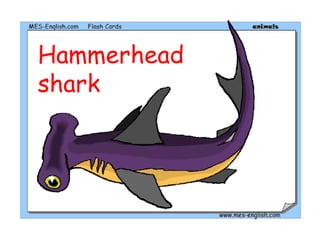

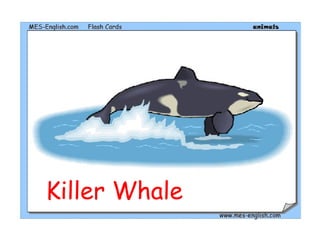




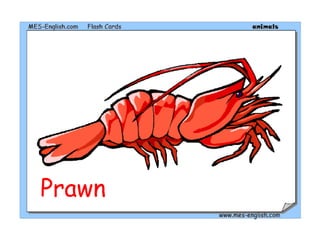

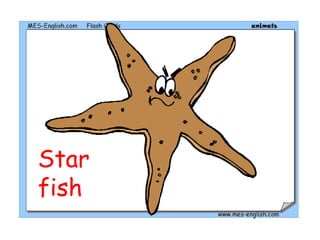
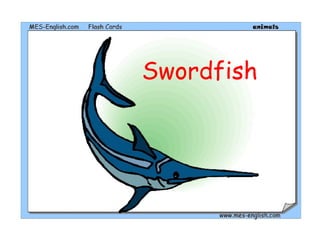
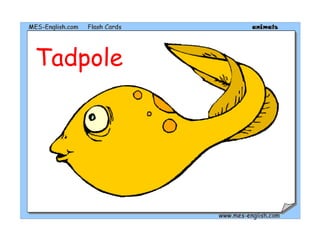
Ad
Recommended
Animals4
Animals4Ict Krutao
Ã˝
This document lists various sea creatures including clam, crab, eel, hammerhead shark, jellyfish, killer whale, lobster, octopus, ray fish, squid, starfish, swordfish, and tadpole. Most of the creatures listed are common ocean inhabitants while others like tadpole can live both in water and on land during different parts of their lifecycle. The document provides a sampling of diverse sea life.Animals 02
Animals 02scorpions1999
Ã˝
This document contains a list of various sea creatures including clams, crabs, eels, hammerhead sharks, jellyfish, killer whales, lobsters, octopuses, ray fish, squid, starfish, swordfish, and tadpoles.Flashcards
Flashcards14mary_93
Ã˝
This document lists various marine animals including whales, dolphins, octopuses, sea horses, jellyfish, sharks, rays, hermit crabs, turtles, starfish and fish.Audio worksheet
Audio worksheetltlehawk
Ã˝
The document lists various types of animals including rattlesnakes, deer, tadpoles, lobsters, jellyfish, starfish, dolphins, coyotes, whales, sharks, clownfish, bass, frogs, camels, jaguars, foxes, chinchillas, catfish, cardinals, squirrels, orangutans, lizards, owls, hawks, red foxes, parrots, great blue herons, gorillas, and red eyed frogs.Camp keep vocabulary animals
Camp keep vocabulary animalsJolene Berg
Ã˝
This document lists various animals that can be found near or at Camp KEEP Vocabulary including sea otters, harbor seals, sea lions, birds of prey such as peregrine falcons and hawks, smaller birds like hummingbirds and shore birds, larger birds including great egrets, great blue herons and pelicans, and land animals such as squirrels, bobcats, deer, coyotes, rabbits and wood rats.Carlie r8
Carlie r8Year56
Ã˝
The climate in the marine environment is typically warm, with temperatures between 18 to 26 degrees Celsius in the winter and cooler winds year-round. The oceans cover 70% of the Earth's surface, with the Pacific Ocean alone encompassing 30%. Marine life inhabits all oceans around the world and includes animals like fish, whales, seals, and birds, as well as plants such as seaweed, kelp, algae, and coral.Animal and birds wet lands of pakistan
Animal and birds wet lands of pakistanMuhammad Naveed Laskani
Ã˝
This document lists various animals that can be found near bodies of water including mink, otters, turtles, fish, ducks, geese, coots, king rails, carmorents and more hen.Animals vocabulary part 3
Animals vocabulary part 3La Paradoja educativa
Ã˝
This document lists the names of various animals and insects. It includes common creatures such as ants, butterflies, cats, dogs, frogs, snakes as well as less common ones like geckos, hippopotamus, newts, praying mantis, sea urchins, and starfish. There is no other context provided.Animals Part 1
Animals Part 1La Paradoja educativa
Ã˝
The document lists various animals including fish, cat, fly, cockrel, cow, frog, canarie, crab, eagle, fox, gorilla, jellyfish, elephant, dog, dolphin, alligator, bear, bull, ant, bee, bird, bat, donkey, duck, mare, hen, horse, groundhog, goat, and girrafe. It appears to be an alphabetical listing of animal names.Animals vocabulary part 2
Animals vocabulary part 2La Paradoja educativa
Ã˝
This document lists various animal species including mammals, birds, reptiles, fish, and invertebrates. It contains both land animals like badger, deer, donkey, wolf, sheep, eagle, vulture, snake, beaver, ostrich, raccoon, otter, pig, woodpecker, turkey, goose, heron, hawk, calf, and camel. It also lists sea and water animals such as pelican, shark, seahorse, whale, turtle, eel, octopus, owl, sea turtle, and pigeon.Animals1
Animals1Julieth Gil Ardila
Ã˝
This document lists different animals including bear, cow, fish, turtle, elephant, gorilla, hippo, horse, lion, panda, rabbit, duck, frog, and zebra.Flashcards sea-animals
Flashcards sea-animalsGiovanna Rodriguez
Ã˝
This document lists various marine animals including fish, invertebrates, and mammals. It includes angel fish, seahorse, starfish, jellyfish, crab, lobster, octopus, squid, shark, dolphin, whale, dugong, piranha, stonefish, sea snail, and sea snake.Animals
Animalssoniagrizq
Ã˝
This document lists various sea creatures including clam, crab, eel, hammerhead shark, jellyfish, killer whale, lobster, octopus, ray fish, squid, starfish, swordfish, and tadpole.Animals1
Animals1Hasan Ege
Ã˝
This short document contains a list of 14 animals including bear, camel, cow, fish, turtle, elephant, gorilla, hippo, horse, lion, panda, rabbit, penguin, and duck.Animals characteristics
Animals characteristics La Paradoja educativa
Ã˝
This document lists various animal body parts and features such as fur, tail, beak, wing, scales, feathers, claw, whiskers, paw, mane, hoof, horn, jaws, eyelid, forearm, waist, fist, thumb, and wrist. It does not provide any context or connection between the listed terms.Animals Part No..1
Animals Part No..1La Paradoja educativa
Ã˝
This document lists various animals in no particular order, including golden fish, cat, fly, cockrel, fish, cow, frog, canarie, crab, eagle, fox, gorilla, jellyfish, elephant, dog, dolphin, alligator, bear, bull, ant, bee, bird, bat, donkey, duck, mare, hen, horse, groundhog, goat, girrafe, and duck, with the final word being "Animals".Mod 4 lesson 9
Mod 4 lesson 9mlabuski
Ã˝
This document outlines lessons from a math module on writing addition and subtraction expressions. It provides examples of how to write expressions for addition, subtraction, increasing or decreasing numbers, and the order of operations. Students are given practice writing expressions for word problems involving sums, differences, and numbers increased or decreased by other amounts. The document emphasizes using diagrams and properties like order of operations to ensure expressions are written correctly.Numbers part 1 prep 4 and 5
Numbers part 1 prep 4 and 5WizKids Learning
Ã˝
The document defines and describes several types of numbers including odd numbers, prime numbers, composite numbers, even numbers, and rectangle, square, and cube numbers. It notes that odd numbers leave a remainder of 1 when divided by 2, prime numbers can only be divided by 1 and themselves, and composite numbers have more than 2 factors. The document provides brief definitions and characteristics for each type of number.Real Numbers
Real NumbersSarah525
Ã˝
Real numbers include rational and irrational numbers. Rational numbers are numbers that can be expressed as a ratio of two integers, such as integers, repeating decimals, and terminating decimals. Irrational numbers are numbers that cannot be expressed as a ratio of integers and continue endlessly without a repeating pattern, such as the square root of two and pi. Real numbers comprise all numbers including rational numbers like integers and irrational numbers.Subject-verb agreement (grammar)
Subject-verb agreement (grammar)Criselda Ymbong
Ã˝
This document discusses rules for subject-verb agreement in English grammar. It provides examples of how singular and plural subjects determine the form of the verb. Indefinite pronouns like everyone and each are always singular. Verbs agreeing with compound subjects depend on the number of the closest subject. Phrases between subjects and verbs do not affect the agreement. Fractions can take singular or plural verbs depending on whether the quantity is countable.Body
BodyHasan Ege
Ã˝
This document lists various parts of the human body including head, hair, face, nose, ear, eye, mouth, teeth, neck, hand, finger, arm, elbow, knee, shoulder, back, foot, toe, and leg.Basic Shapes
Basic ShapesHasan Ege
Ã˝
This document lists common basic shapes including circles, squares, rectangles, triangles, ovals, trapezoids, parallelograms, pentagons, hexagons, octagons, diamonds, stars, hearts, arrows, crescents, cubes, cylinders, cones, pyramids and rectangular solids.Even and odd numbers
Even and odd numbersAbdelrahman Nasir
Ã˝
This document discusses even and odd numbers. Even numbers can be divided evenly by two without a remainder, with examples given like 2, 4, 6, etc. Odd numbers cannot be divided evenly by two, with examples like 1, 3, 5, etc. A few number examples are provided and identified as even or odd to demonstrate the difference between the two number types.Numbers
NumbersClinInsight
Ã˝
This document provides an overview of different types of numbers including integers, even and odd numbers, prime and composite numbers, and co-prime numbers. It also describes methods for comparing numbers based on place value and detecting whether a number is prime. Key details include definitions of integers, even and odd numbers, prime and composite numbers. A prime number detection method is outlined in 5 steps including using the formula n^2 >= p to identify possible factors to test divisibility.Dharapat
DharapatSoftWorks
Ã˝
Dharapat is an educational tool designed for iPad, iPhone, and Android devices that helps users learn Bangla numbers from 1 to 10, counting up to 100, and concepts like odd-even numbers and basic arithmetic. It features colorful pictures and provides pronunciation and English cues to enhance learning.Odd and Even Numbers
Odd and Even Numbersyojm
Ã˝
This document defines even and odd numbers. Even numbers can be divided evenly by 2 and have last digits of 0, 2, 4, 6, or 8. Odd numbers cannot be divided evenly by 2 and have last digits of 1, 3, 5, 7, or 9. The document then asks which of 33 or 20 is odd (33 is odd) and which of 34,565 or 62,846 is even (34,565 is even).Basic Shapes
Basic ShapesImmer Manalu
Ã˝
The document introduces different shapes, including quadrilaterals like squares, rectangles, parallelograms, rhombuses, and kites. It also covers triangles and polygons with six sides like hexagons and five sides like pentagons. Each shape is presented with a question about its name and the corresponding answer.Lecture9 multi kernel_svm
Lecture9 multi kernel_svmStéphane Canu
Ã˝
This document summarizes a lecture on multi-kernel support vector machines (SVM). It introduces multiple kernel learning (MKL), which allows using a combination of multiple kernel functions instead of a single kernel for SVM classification and regression. MKL learns the optimal combination of kernels by solving a convex optimization problem to find the kernel weights while training the SVM. The SimpleMKL algorithm is presented for efficiently solving the MKL problem using a reduced gradient approach. Experimental results on regression datasets demonstrate that MKL can improve performance over single kernel SVMs.Lesson 2 Addition & Subtraction
Lesson 2 Addition & SubtractionBryan Dunn
Ã˝
The document provides lesson content on addition and subtraction of whole numbers. It includes examples and explanations of key concepts like finding the sum, carrying, borrowing, properties of addition/subtraction, and word problems. Practice problems are provided at the end to solve applications using the whole number operations and problem-solving process covered in the lesson.More Related Content
What's hot (9)
Animals Part 1
Animals Part 1La Paradoja educativa
Ã˝
The document lists various animals including fish, cat, fly, cockrel, cow, frog, canarie, crab, eagle, fox, gorilla, jellyfish, elephant, dog, dolphin, alligator, bear, bull, ant, bee, bird, bat, donkey, duck, mare, hen, horse, groundhog, goat, and girrafe. It appears to be an alphabetical listing of animal names.Animals vocabulary part 2
Animals vocabulary part 2La Paradoja educativa
Ã˝
This document lists various animal species including mammals, birds, reptiles, fish, and invertebrates. It contains both land animals like badger, deer, donkey, wolf, sheep, eagle, vulture, snake, beaver, ostrich, raccoon, otter, pig, woodpecker, turkey, goose, heron, hawk, calf, and camel. It also lists sea and water animals such as pelican, shark, seahorse, whale, turtle, eel, octopus, owl, sea turtle, and pigeon.Animals1
Animals1Julieth Gil Ardila
Ã˝
This document lists different animals including bear, cow, fish, turtle, elephant, gorilla, hippo, horse, lion, panda, rabbit, duck, frog, and zebra.Flashcards sea-animals
Flashcards sea-animalsGiovanna Rodriguez
Ã˝
This document lists various marine animals including fish, invertebrates, and mammals. It includes angel fish, seahorse, starfish, jellyfish, crab, lobster, octopus, squid, shark, dolphin, whale, dugong, piranha, stonefish, sea snail, and sea snake.Animals
Animalssoniagrizq
Ã˝
This document lists various sea creatures including clam, crab, eel, hammerhead shark, jellyfish, killer whale, lobster, octopus, ray fish, squid, starfish, swordfish, and tadpole.Animals1
Animals1Hasan Ege
Ã˝
This short document contains a list of 14 animals including bear, camel, cow, fish, turtle, elephant, gorilla, hippo, horse, lion, panda, rabbit, penguin, and duck.Animals characteristics
Animals characteristics La Paradoja educativa
Ã˝
This document lists various animal body parts and features such as fur, tail, beak, wing, scales, feathers, claw, whiskers, paw, mane, hoof, horn, jaws, eyelid, forearm, waist, fist, thumb, and wrist. It does not provide any context or connection between the listed terms.Animals Part No..1
Animals Part No..1La Paradoja educativa
Ã˝
This document lists various animals in no particular order, including golden fish, cat, fly, cockrel, fish, cow, frog, canarie, crab, eagle, fox, gorilla, jellyfish, elephant, dog, dolphin, alligator, bear, bull, ant, bee, bird, bat, donkey, duck, mare, hen, horse, groundhog, goat, girrafe, and duck, with the final word being "Animals".Viewers also liked (20)
Mod 4 lesson 9
Mod 4 lesson 9mlabuski
Ã˝
This document outlines lessons from a math module on writing addition and subtraction expressions. It provides examples of how to write expressions for addition, subtraction, increasing or decreasing numbers, and the order of operations. Students are given practice writing expressions for word problems involving sums, differences, and numbers increased or decreased by other amounts. The document emphasizes using diagrams and properties like order of operations to ensure expressions are written correctly.Numbers part 1 prep 4 and 5
Numbers part 1 prep 4 and 5WizKids Learning
Ã˝
The document defines and describes several types of numbers including odd numbers, prime numbers, composite numbers, even numbers, and rectangle, square, and cube numbers. It notes that odd numbers leave a remainder of 1 when divided by 2, prime numbers can only be divided by 1 and themselves, and composite numbers have more than 2 factors. The document provides brief definitions and characteristics for each type of number.Real Numbers
Real NumbersSarah525
Ã˝
Real numbers include rational and irrational numbers. Rational numbers are numbers that can be expressed as a ratio of two integers, such as integers, repeating decimals, and terminating decimals. Irrational numbers are numbers that cannot be expressed as a ratio of integers and continue endlessly without a repeating pattern, such as the square root of two and pi. Real numbers comprise all numbers including rational numbers like integers and irrational numbers.Subject-verb agreement (grammar)
Subject-verb agreement (grammar)Criselda Ymbong
Ã˝
This document discusses rules for subject-verb agreement in English grammar. It provides examples of how singular and plural subjects determine the form of the verb. Indefinite pronouns like everyone and each are always singular. Verbs agreeing with compound subjects depend on the number of the closest subject. Phrases between subjects and verbs do not affect the agreement. Fractions can take singular or plural verbs depending on whether the quantity is countable.Body
BodyHasan Ege
Ã˝
This document lists various parts of the human body including head, hair, face, nose, ear, eye, mouth, teeth, neck, hand, finger, arm, elbow, knee, shoulder, back, foot, toe, and leg.Basic Shapes
Basic ShapesHasan Ege
Ã˝
This document lists common basic shapes including circles, squares, rectangles, triangles, ovals, trapezoids, parallelograms, pentagons, hexagons, octagons, diamonds, stars, hearts, arrows, crescents, cubes, cylinders, cones, pyramids and rectangular solids.Even and odd numbers
Even and odd numbersAbdelrahman Nasir
Ã˝
This document discusses even and odd numbers. Even numbers can be divided evenly by two without a remainder, with examples given like 2, 4, 6, etc. Odd numbers cannot be divided evenly by two, with examples like 1, 3, 5, etc. A few number examples are provided and identified as even or odd to demonstrate the difference between the two number types.Numbers
NumbersClinInsight
Ã˝
This document provides an overview of different types of numbers including integers, even and odd numbers, prime and composite numbers, and co-prime numbers. It also describes methods for comparing numbers based on place value and detecting whether a number is prime. Key details include definitions of integers, even and odd numbers, prime and composite numbers. A prime number detection method is outlined in 5 steps including using the formula n^2 >= p to identify possible factors to test divisibility.Dharapat
DharapatSoftWorks
Ã˝
Dharapat is an educational tool designed for iPad, iPhone, and Android devices that helps users learn Bangla numbers from 1 to 10, counting up to 100, and concepts like odd-even numbers and basic arithmetic. It features colorful pictures and provides pronunciation and English cues to enhance learning.Odd and Even Numbers
Odd and Even Numbersyojm
Ã˝
This document defines even and odd numbers. Even numbers can be divided evenly by 2 and have last digits of 0, 2, 4, 6, or 8. Odd numbers cannot be divided evenly by 2 and have last digits of 1, 3, 5, 7, or 9. The document then asks which of 33 or 20 is odd (33 is odd) and which of 34,565 or 62,846 is even (34,565 is even).Basic Shapes
Basic ShapesImmer Manalu
Ã˝
The document introduces different shapes, including quadrilaterals like squares, rectangles, parallelograms, rhombuses, and kites. It also covers triangles and polygons with six sides like hexagons and five sides like pentagons. Each shape is presented with a question about its name and the corresponding answer.Lecture9 multi kernel_svm
Lecture9 multi kernel_svmStéphane Canu
Ã˝
This document summarizes a lecture on multi-kernel support vector machines (SVM). It introduces multiple kernel learning (MKL), which allows using a combination of multiple kernel functions instead of a single kernel for SVM classification and regression. MKL learns the optimal combination of kernels by solving a convex optimization problem to find the kernel weights while training the SVM. The SimpleMKL algorithm is presented for efficiently solving the MKL problem using a reduced gradient approach. Experimental results on regression datasets demonstrate that MKL can improve performance over single kernel SVMs.Lesson 2 Addition & Subtraction
Lesson 2 Addition & SubtractionBryan Dunn
Ã˝
The document provides lesson content on addition and subtraction of whole numbers. It includes examples and explanations of key concepts like finding the sum, carrying, borrowing, properties of addition/subtraction, and word problems. Practice problems are provided at the end to solve applications using the whole number operations and problem-solving process covered in the lesson.Kinds Igneous Rocks
Kinds Igneous RocksamjekOo Jai
Ã˝
Igneous rocks are formed by the cooling and hardening of magma, making them the primary rocks of the Earth's crust. Examples of igneous rocks include rhyolite, diabase, granite, basalt, and diorite. Igneous means "formed from fire."Money- Counting Coins
Money- Counting Coinsashleyjudy
Ã˝
This document provides information about different United States coins, including pennies, nickels, dimes and quarters. It counts out examples of each coin up to $1 and provides rhyming descriptions of dimes and quarters, noting that dimes are worth 10 cents and quarters are worth 25 cents.Parts of the body and clothes
Parts of the body and clothesAmandabugarin
Ã˝
This document lists common parts of the human body including eyes, ears, arms, feet, fingers, hair, hands, head, knees, legs, mouth, nose, shoulders, and toes. It also lists various articles of clothing such as coats, scarves, ties, gloves, boots, slippers, blouses, jeans, hats, trousers, shoes, dresses, T-shirts, jackets, shirts, sweaters, skirts, and socks.Plant kingdom
Plant kingdomLuisa Cambero Barriga
Ã˝
This document provides information about different parts of plants and how they function. It discusses the five main parts of plants: roots, stems, leaves, flowers, and seeds. For each part, it describes the key jobs or functions, such as roots holding the plant and taking in water and food from the soil. It also covers different ways of classifying plants, the life cycle of deciduous trees, and how plants reproduce.Play Group English Learning Alphabet 1 (I-K)
Play Group English Learning Alphabet 1 (I-K)Cambriannews
Ã˝
The document teaches the alphabet letters I, J, and K. It divides students into groups to learn the letters from flash cards, then evaluates their learning.Air and weather
Air and weatherLuisa Cambero Barriga
Ã˝
The document discusses weather and climate concepts including the four seasons, weather instruments, types of wind and precipitation, and the water cycle. It describes the seasons in Spain and common instruments like a thermometer and rain gauge used to measure temperature, wind direction, and rainfall. Evaporation, condensation, and precipitation are explained as the key parts of the water cycle that move water through the atmosphere and environment.Nouns Introduction
Nouns Introduction WizKids Learning
Ã˝
This document defines nouns and provides examples of different types of nouns. It states that a noun is the name of a person, place, animal, thing, quality, or idea. It then lists examples of nouns under the categories of persons, places, animals, things, and abstract concepts/qualities and ideas. The document concludes by stating that if a word can be classified as a person, place, animal, thing, quality, or idea, then it is a noun.Ad
More from Hasan Ege (20)
Our school turkey
Our school turkeyHasan Ege
Ã˝
Nazmi Topçuoğlu Primary School is located in İncirliova, Aydın. The school has one director, one director's assistant, ten teachers, one officer, and two cleaning staff. It currently has 174 students. The school building was originally opened as a hospital in 1963 and later served as a health center for many years before becoming an elementary school in 2000. The school is named after Nazmi Topçuoğlu, a politician born in 1892 who served as a member of parliament and commerce minister.Aydin
AydinHasan Ege
Ã˝
Aydin province in western Turkey has a highly developed tourism and agriculture industry thanks to its coastal location and climate. It has many historical sites from ancient civilizations like Milet and Priene as well as Turkey's first railway. Tourism is centered around the coastal cities of Kusadasi and Didyma, and Aydin is known for producing olive oil, grapes, cotton, and other crops. The culture features traditional folk dances like Zeybek and camel wrestling events.Turkey
TurkeyHasan Ege
Ã˝
Turkey is a transcontinental country located in both Western Asia and Southeastern Europe, bordering 8 other countries. It has a population of over 80 million and its largest city, Istanbul, spans two continents and has over 14 million residents. The modern Turkish Republic was established in 1923 under the leadership of Mustafa Kemal Ataturk following the fall of the Ottoman Empire.How we protect environment turkey
How we protect environment turkeyHasan Ege
Ã˝
The document outlines various ways to protect the environment, such as using bicycles instead of cars, raising awareness about global warming, keeping the environment clean, conserving resources, reducing electrical appliance and wood stove use, reusing items, interacting positively with plants and animals, choosing green alternatives, maintaining healthy ecosystems, reducing carbon footprints and pollution, growing food locally, and planting more trees.Classroom Hazir
Classroom HazirHasan Ege
Ã˝
This document lists common classroom supplies such as a pencil, pen, crayon, paper, book, ruler, scissors, notebook, rubber eraser, pencil sharpener, desk, blackboard, and computer chair. It provides a simple list of basic classroom items without additional context or description.Iso 8859 9 Family Members
Iso 8859 9 Family MembersHasan Ege
Ã˝
This document outlines Carol's family tree, identifying her relationships to her father Charles, mother Helen, grandparents Julia and Edward, uncle George and aunt Megan, and cousins Sarah, Peter, and John. It provides information about how each family member is related to Carol and others in the family.Likedislike
LikedislikeHasan Ege
Ã˝
The document introduces several people such as a veterinarian, footballer, engineer, and astronomer who each like different activities related to their professions such as animals, football, computers, and observing stars. It then asks the reader what activities they like and lists additional people such as musicians and teachers who enjoy music, football, teaching, and dancing.Need Dontneed
Need DontneedHasan Ege
Ã˝
The document discusses what school supplies are needed, asking if a pencil, cap, book, crayons, and pillow are required, and determining that a pencil, book, crayons, and lunch are needed but a cap and pillow are not. It concludes by stating lunch is needed to have something to eat when hungry at school.Christmas2
Christmas2Hasan Ege
Ã˝
This document lists various Christmas-related terms in no particular order, including Holly, Chimney, North Pole, Wreath, Decoration, Carol Singing, Snowflake, Decorate the Tree, Candle, Fireplace, Gingerbread Man, Nativity Scene, and The Three Wise Men.Christmas1
Christmas1Hasan Ege
Ã˝
This document lists common symbols and icons associated with Christmas, including Santa Claus, Christmas trees, toys, stockings, presents, candy canes, reindeer, sleighs, snowmen, lights, bells, angels, elves, bows, and mistletoe.Chores
ChoresHasan Ege
Ã˝
This document provides a list of common household chores including doing laundry, yard work tasks like mowing the lawn and watering grass, indoor cleaning tasks such as doing dishes, sweeping, vacuuming and mopping floors, and other chores like taking out rubbish, raking leaves, cleaning windows and cupboards, dusting, walking and feeding the dog, and washing the dog.Body Parts
Body PartsHasan Ege
Ã˝
This document lists various body parts including ears, eyes, hands, head, knees, mouth, nose, shoulders, stomach and toes. It provides a simple list of 10 common body parts without additional context or details about each part. The list appears to name external and visible body parts located on the front and top half of the human body.Body Parts 2
Body Parts 2Hasan Ege
Ã˝
This document lists various parts of the human body including the arm, back, bottom, chest, chin, elbow, feet, hand, and leg.Breakfast
BreakfastHasan Ege
Ã˝
This document lists various breakfast foods including bread, cereal, cheese, croissant, eggs, fried eggs, jam, pancake, rice and toast.As As
As AsHasan Ege
Ã˝
The document makes comparisons between various people, objects, places and their characteristics such as cuteness, bravery, expensiveness, length, healthiness, crowdedness, coldness, sweetness, beauty, handsomeness, luxury, value, comfort, cleanliness, friendliness, speed, luck, usefulness, and anger. It uses phrases like "as...as" to indicate equivalency or lack of equivalency between the items being compared.Bathroom
BathroomHasan Ege
Ã˝
This document contains a list of common bathroom items including bathtub, comb, hair brush, hair dryer, laundry basket, scale, razor, shaving cream, towel, towel rack, sink, shower, soap, toilet, toilet paper, toothpaste, and toothbrush.At On In
At On InHasan Ege
Ã˝
This document provides examples of using prepositions of time and place such as "at", "on", and "in". It gives 30 practice sentences showing how to indicate the time using these prepositions like "at 2 p.m." or the place using addresses or locations like "in Seattle". The document aims to help practice the proper use of these prepositions in indicating when and where events take place.Bedroom
BedroomHasan Ege
Ã˝
This document lists various common furniture and items that can be found in a bedroom, including a bed, pillow, blanket, dresser, bookshelf, table, wardrobe, lamp, rug, mirror, clock, toys, curtains, and stereo.Animals 1
Animals 1Hasan Ege
Ã˝
The document lists various animal names, including bat, bee, bear, bird, camel, cat, chick, chicken, cock, cow, dog, dolphin, donkey, duck, eagle, elephant, fish, fox, frog, goat, horse, lamp, sheep, lion, monkey, mouse, panda, parrot, pig, rabbit, snake, wolf, tortoise, and zebra. It ends by wishing students a nice day.Ad
Recently uploaded (20)
Publishing Your Memoir with Brooke Warner
Publishing Your Memoir with Brooke WarnerBrooke Warner
Ã˝
Brooke Warner presents on getting published - traditional, hybrid, and self-publishing.
www.memoirnation.comROLE PLAY: FIRST AID -CPR & RECOVERY POSITION.pptx
ROLE PLAY: FIRST AID -CPR & RECOVERY POSITION.pptxBelicia R.S
Ã˝
Role play : First Aid- CPR, Recovery position and Hand hygiene.
Scene 1: Three friends are shopping in a mall
Scene 2: One of the friend becomes victim to electric shock.
Scene 3: Arrival of a first aider
Steps:
Safety First
Evaluate the victim‘s condition
Call for help
Perform CPR- Secure an open airway, Chest compression, Recuse breaths.
Put the victim in Recovery position if unconscious and breathing normally.
How to Implement Least Package Removal Strategy in Odoo 18 Inventory
How to Implement Least Package Removal Strategy in Odoo 18 InventoryCeline George
Ã˝
In Odoo, the least package removal strategy is a feature designed to optimize inventory management by minimizing the number of packages open to fulfill the orders. This strategy is particularly useful for the business that deals with products packages in various quantities such as boxes, cartons or palettes. Battle of Bookworms 2025 - U25 Literature Quiz by Pragya
Battle of Bookworms 2025 - U25 Literature Quiz by Pragya Pragya - UEM Kolkata Quiz Club
Ã˝
Battle of Bookworms is a literature quiz organized by Pragya, UEM Kolkata, as part of their cultural fest Ecstasia. Curated by quizmasters Drisana Bhattacharyya, Argha Saha, and Aniket Adhikari, the quiz was a dynamic mix of classical literature, modern writing, mythology, regional texts, and experimental literary forms. It began with a 20-question prelim round where ‘star questions’ played a key tie-breaking role. The top 8 teams moved into advanced rounds, where they faced audio-visual challenges, pounce/bounce formats, immunity tokens, and theme-based risk-reward questions. From Orwell and Hemingway to Tagore and Sarala Das, the quiz traversed a global and Indian literary landscape. Unique rounds explored slipstream fiction, constrained writing, adaptations, and true crime literature. It included signature IDs, character identifications, and open-pounce selections. Questions were crafted to test contextual understanding, narrative knowledge, and authorial intent, making the quiz both intellectually rewarding and culturally rich. Battle of Bookworms proved literature quizzes can be insightful, creative, and deeply enjoyable for all.Community Health Nursing Approaches, Concepts, Roles & Responsibilities – Uni...
Community Health Nursing Approaches, Concepts, Roles & Responsibilities – Uni...RAKESH SAJJAN
Ã˝
This PowerPoint presentation is based on Unit 6 – Community Health Nursing Approaches, Concepts, Roles & Responsibilities of Community Health Nursing Personnel, designed for B.Sc Nursing 5th Semester students under the subject Community Health Nursing – I, following the syllabus of the Indian Nursing Council (INC).
This unit focuses on the various approaches in community health, the organizational framework, and the responsibilities of different levels of nursing staff in the healthcare system. It emphasizes the real-world application of nursing principles to provide comprehensive and preventive care to the community.
üìò Key Areas Covered in this Presentation:
Introduction to the concept of community health nursing
Approaches to community health:
Nursing Process Approach
Epidemiological Approach
Evidence-Based Approach
Problem-Solving Approach
Nursing Theories in Community Health Practice
Explanation of teamwork and intersectoral coordination
Concept of primary health care and its application in community nursing
Levels of health care delivery – primary, secondary, and tertiary care
Home visit process: principles, planning, implementation, and follow-up
Use of community bag and record maintenance
Roles and responsibilities of:
Auxiliary Nurse Midwives (ANMs)
Community Health Officers (CHOs)
Staff Nurses
ASHA workers
Public Health Nurses (PHNs)
Documentation and reporting in community settings
Promotion of health education, immunization, maternal and child health, and nutritional support
Role of nurse in disease surveillance, outbreak control, and health promotion
Ethical principles in community nursing
Coordination with health team members and village health committees
This presentation is useful for:
Nursing students preparing for university theory exams, class tests, or viva
Nursing educators conducting lectures or field discussions
Interns and trainees working in PHCs, sub-centers, or community settings
Community nurses and health educators involved in rural and urban outreach
The content is simplified, clear, and enhanced with point-wise explanations, flowcharts, and field-related examples for better retention and application.Communicable Diseases and National Health Programs – Unit 9 | B.Sc Nursing 5t...
Communicable Diseases and National Health Programs – Unit 9 | B.Sc Nursing 5t...RAKESH SAJJAN
Ã˝
This PowerPoint presentation covers Unit 9 – Communicable Diseases and National Health Programs, a core part of the 5th Semester B.Sc Nursing (Community Health Nursing – I) syllabus, as outlined by the Indian Nursing Council (INC).
This unit enables nursing students to understand the epidemiology, prevention, control, and nursing management of common communicable diseases in India, while also offering a structured overview of the National Health Programs implemented to address them.
The content is critical for effective field practice, disease surveillance, early detection, referral, and health education, equipping students to participate in public health interventions and outbreak control at community and national levels.
üìò Key Topics Covered in the PPT:
Definition and classification of communicable diseases
Modes of transmission and chain of infection
Common communicable diseases in India:
Malaria
Tuberculosis
Leprosy
Dengue
HIV/AIDS
Hepatitis
COVID-19 (if included in the current curriculum)
Diarrheal diseases
Acute Respiratory Infections (ARIs)
Epidemiological factors, causative agents, symptoms, and incubation periods
Prevention and control strategies: primary, secondary, and tertiary levels
Nursing responsibilities in patient care, contact tracing, community surveillance, and outbreak control
Health education and behavior change communication for community awareness
Vaccination schedules and cold chain maintenance
National Health Programs related to communicable diseases:
National Vector Borne Disease Control Program (NVBDCP)
Revised National Tuberculosis Control Program (RNTCP)
National Leprosy Eradication Program (NLEP)
National AIDS Control Program (NACP)
Universal Immunization Program (UIP)
IDSP – Integrated Disease Surveillance Program
Overview of standard treatment protocols, referral mechanisms, and community nurse’s role in program implementation
This presentation is ideal for:
Nursing students preparing for university exams, class tests, and field projects
Tutors teaching infectious disease nursing and public health interventions
Nurses involved in immunization, outbreak investigation, and contact tracing
It provides a student-friendly breakdown of concepts, aligned with national priorities, including flowcharts, tables, case examples, and simplified text for field-level application.K12 Tableau User Group virtual event June 18, 2025
K12 Tableau User Group virtual event June 18, 2025dogden2
Ã˝
National K12 Tableau User Group: June 2025 meeting slidesBirnagar High School Platinum Jubilee Quiz.pptx
Birnagar High School Platinum Jubilee Quiz.pptxSourav Kr Podder
Ã˝
Birnagar High School Platinum Jubilee Celebration QuizTanja Vujicic - PISA for Schools contact Info
Tanja Vujicic - PISA for Schools contact InfoEduSkills OECD
Ã˝
Tanja Vujicic, Senior Analyst and PISA for School’s Project Manager at the OECD spoke at the OECD webinar 'Turning insights into impact: What do early case studies reveal about the power of PISA for Schools?' on 20 June 2025
PISA for Schools is an OECD assessment that evaluates 15-year-old performance on reading, mathematics, and science. It also gathers insights into students’ learning environment, engagement and well-being, offering schools valuable data that help them benchmark performance internationally and improve education outcomes. A central ambition, and ongoing challenge, has been translating these insights into meaningful actions that drives lasting school improvement. Q1_ENGLISH_PPT_WEEK 1 power point grade 3 Quarter 1 week 1
Q1_ENGLISH_PPT_WEEK 1 power point grade 3 Quarter 1 week 1jutaydeonne
Ã˝
Grade 3 Quarter 1 Week 1 English part 2Nutrition Assessment and Nutrition Education – Unit 4 | B.Sc Nursing 5th Seme...
Nutrition Assessment and Nutrition Education – Unit 4 | B.Sc Nursing 5th Seme...RAKESH SAJJAN
Ã˝
This PowerPoint presentation is based on Unit 4 – Nutrition Assessment and Nutrition Education, a core topic in the 5th Semester of B.Sc Nursing under the subject Community Health Nursing – I, as per the Indian Nursing Council (INC) guidelines.
The unit provides foundational knowledge of nutritional assessment techniques, importance of balanced diets, and health education strategies aimed at improving community nutrition. It empowers future nurses to play a key role in promoting nutrition, preventing malnutrition, and implementing dietary interventions at individual, family, and community levels.
‚úÖ The PPT covers the following topics in detail:
Introduction to Nutrition and its role in health and disease prevention
Objectives of nutritional assessment in community settings
Types of nutritional assessment – Anthropometric, Biochemical, Clinical, and Dietary (ABCD) methods
Tools and techniques used in each type of nutritional assessment
Interpreting growth charts, BMI, MUAC, and dietary recalls
Identification of malnutrition, both undernutrition and overnutrition
Common nutritional deficiencies – protein-energy malnutrition, anemia, vitamin A deficiency, iodine deficiency
Principles of nutrition education and behavior change communication
Role of community health nurse in nutrition education during home visits, camps, and school health programs
Use of charts, posters, flashcards, and food models in health teaching
Culturally appropriate and locally available food suggestions
Strategies for promoting infant and young child feeding (IYCF)
National nutrition programs: POSHAN Abhiyaan, Mid-Day Meal Scheme, ICDS, and Anemia Mukt Bharat
Monitoring and evaluation of nutrition interventions
This PPT is perfect for:
B.Sc Nursing students preparing for unit tests or university exams
Nursing educators delivering community health lessons
Field work, community posting presentations, or group health teaching
Health educators and ASHA trainers working on community nutrition
All content is student-friendly, professionally formatted, and aligned with public health priorities and practical nursing roles.How payment terms are configured in Odoo 18
How payment terms are configured in Odoo 18Celine George
Ã˝
Payment terms in Odoo 18 help define the conditions for when invoices are due. This feature can split payments into multiple parts and automate due dates based on specific rules.OBSESSIVE COMPULSIVE DISORDER.pptx IN 5TH SEMESTER B.SC NURSING, 2ND YEAR GNM...
OBSESSIVE COMPULSIVE DISORDER.pptx IN 5TH SEMESTER B.SC NURSING, 2ND YEAR GNM...parmarjuli1412
Ã˝
OBSESSIVE COMPULSIVE DISORDER INCLUDED TOPICS ARE INTRODUCTION, DEFINITION OF OBSESSION, DEFINITION OF COMPULSION, MEANING OF OBSESSION AND COMPULSION, DEFINITION OF OBSESSIVE COMPULSIVE DISORDER, EPIDERMIOLOGY OF OCD, ETIOLOGICAL FACTORS OF OCD, CLINICAL SIGN AND SYMPTOMS OF OBSESSION AND COMPULSION, MANAGEMENT INCLUDED PHARMACOTHERAPY(ANTIDEPRESSANT DRUG+ANXIOLYTIC DRUGS), PSYCHOTHERAPY, NURSING MANAGEMENT(ASSESSMENT+DIAGNOSIS+NURSING INTERVENTION+EVALUATION)) Plate Tectonic Boundaries and Continental Drift Theory
Plate Tectonic Boundaries and Continental Drift TheoryMarie
Ã˝
This 28 slide presentation covers the basics of plate tectonics and continental drift theory. It is an effective introduction into a full plate tectonics unit study, but does not cover faults, stress, seismic waves, or seafloor spreading.
To download PDF, visit The Homeschool Daily. We will be uploading more slideshows to follow this one. Blessings, Marie How to Manage Different Customer Addresses in Odoo 18 Accounting
How to Manage Different Customer Addresses in Odoo 18 AccountingCeline George
Ã˝
A business often have customers with multiple locations such as office, warehouse, home addresses and this feature allows us to associate with different addresses with each customer streamlining the process of creating sales order invoices and delivery orders.SCHIZOPHRENIA OTHER PSYCHOTIC DISORDER LIKE Persistent delusion/Capgras syndr...
SCHIZOPHRENIA OTHER PSYCHOTIC DISORDER LIKE Persistent delusion/Capgras syndr...parmarjuli1412
Ã˝
SCHIZOPHRENIA INCLUDED TOPIC IS INTRODUCTION, DEFINITION OF GENERAL TERM IN PSYCHIATRIC, THEN DIFINITION OF SCHIZOPHRENIA, EPIDERMIOLOGY, ETIOLOGICAL FACTORS, CLINICAL FEATURE(SIGN AND SYMPTOMS OF SCHIZOPHRENIA), CLINICAL TYPES OF SCHIZOPHRENIA, DIAGNOSIS, INVESTIGATION, TREATMENT MODALITIES(PHARMACOLOGICAL MANAGEMENT, PSYCHOTHERAPY, ECT, PSYCHO-SOCIO-REHABILITATION), NURSING MANAGEMENT(ASSESSMENT,DIAGNOSIS,NURSING INTERVENTION,AND EVALUATION), OTHER PSYCHOTIC DISORDER LIKE Persistent delusion/Capgras syndrome(The Delusion of Doubles)/Acute and Transient Psychotic Disorders/Induced Delusional Disorders/Schizoaffective Disorder /CAPGRAS SYNDROME(DELUSION OF DOUBLE), GERIATRIC CONSIDERATION, FOLLOW UP, HOMECARE AND REHABILITATION OF THE PATIENT, Animals4
- 1. Copyright © 2005 – 2006 MES-English.com
- 2. Clam
- 3. Crab
- 4. Eel
- 6. Jelly fish
- 7. Killer Whale
- 8. Lobster
- 9. Octopus
- 10. Ray fish
- 11. Sea- horse
- 12. Prawn
- 13. Squid
- 14. Star fish
- 15. Swordfish
- 16. Tadpole
